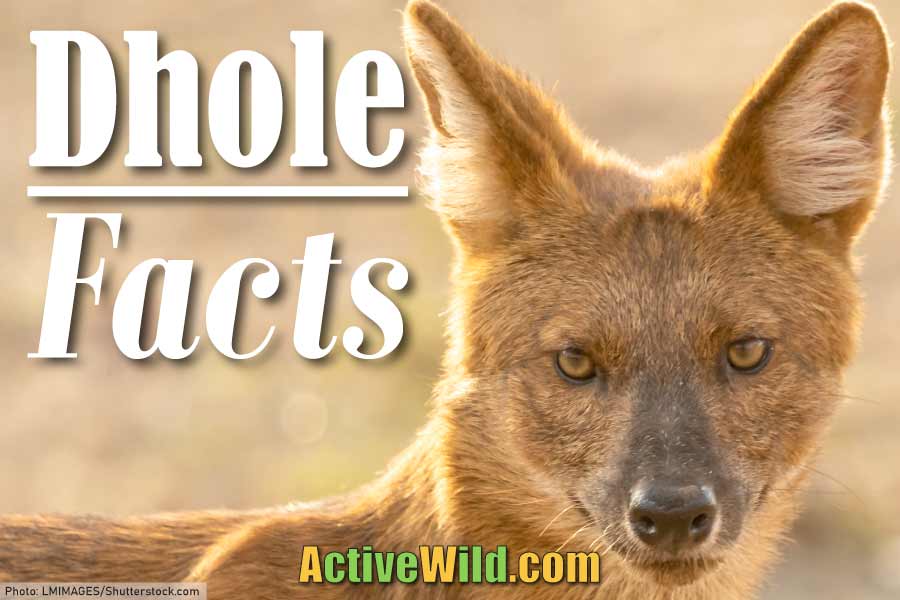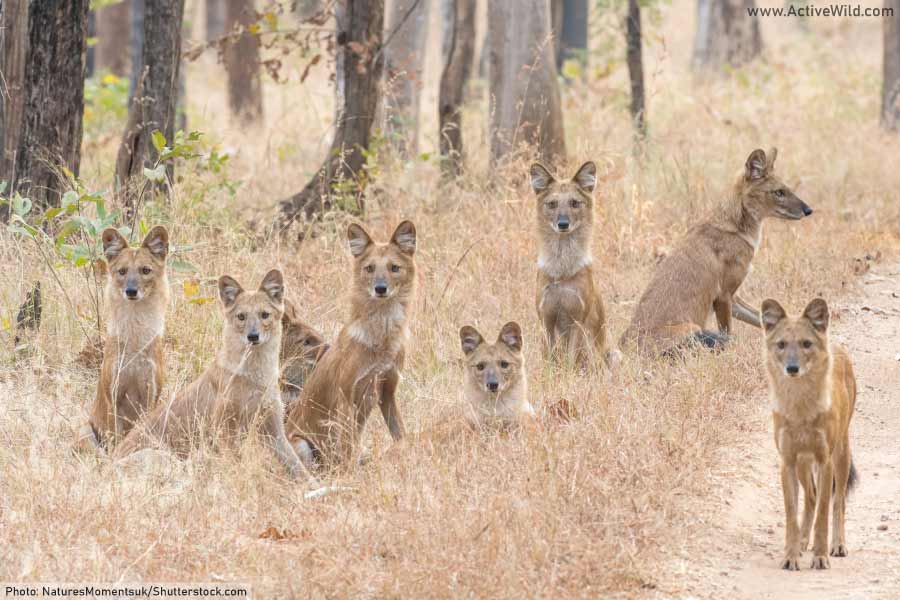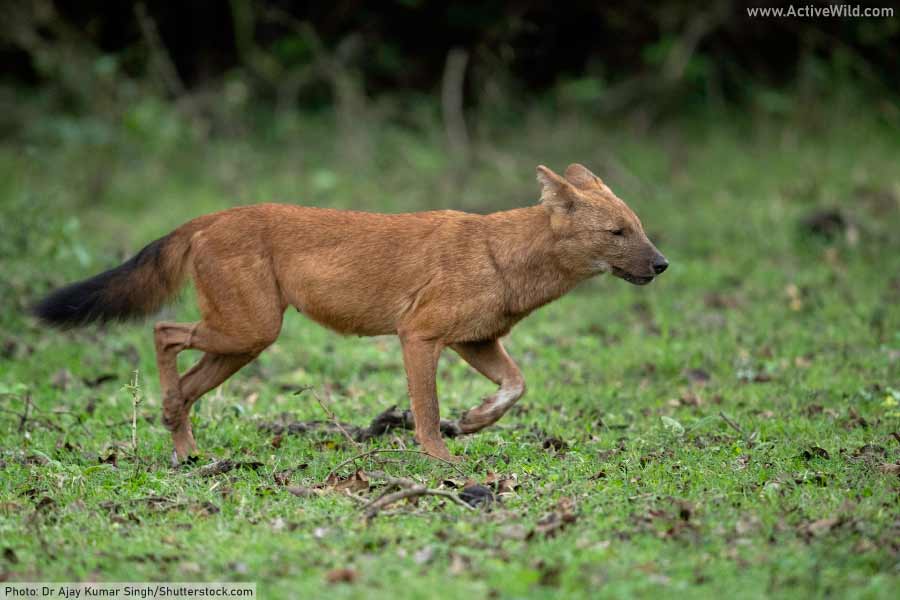Dhole facts, pictures and information. Discover one of the most highly-endangered members of the dog family…
Dhole Facts: Page Index
- What Is A Dhole? Introduction
- Dhole Facts At A Glance
- Dhole Video
- Physical Description: What Does A Dhole Look Like?
- Family And Related Animals
- Where Is The Dhole Found?
- Dhole Habitat
- Behavior / Lifestyle
- Communication
- Diet: What Does A Dhole Eat?
- Dhole Life-Cycle
- Is The Dhole Endangered?
- Further Reading and Related Animals
What Is A Dhole? Introduction
The dhole is a medium-sized member of the dog family, Canidae. It is found in a variety of habitats (including mountains, forests and grasslands) throughout much of Central, South and Southeast Asia.
A highly social animal, the dhole lives in multi-family groups known as ‘clans’, which consist of between 5 and 40 individuals. Members of larger clans break up into smaller packs while hunting.
The dhole’s diet is mainly carnivorous. The species’ main prey are mid-sized ungulates (hoofed animals) such as deer, boar and goats. Being pack hunters, dholes are able to bring down prey much larger than themselves.
Depending on location, the dhole may share its habitat with other, larger predators such as tigers, leopards and bears. In general, the species are able to co-exist due to differences in their preferred prey. Although smaller, the pack-hunting instinct of the dhole allows it to compete against these larger, solo hunters.
The IUCN conservation status of the dhole is Endangered. This is due mainly to habitat loss / fragmentation, lack of available prey animals, and persecution by humans.
Dhole Facts At A Glance
- Alternative Names: Asiatic wild dog, Asian wild dog, whistling dog
- Scientific Name: Cuon alpinus
- Class: Mammalia (Mammal)
- Order: Carnivora
- Family: Canidae (Subfamily: Caninae)
- Genus: Cuon
- Where Found: Central, South and Southeast Asia
- Body & Tail Length: 135 cm (53.15 in.)
- Height At Shoulders: 50 cm (20 in.)
- Average Weight:1 kg (33.29 lb.)
- Conservation Status: Endangered
Dhole Video
The video below features footage of dholes in India’s Kanha National Park. Listen out for the dhole’s bird-like whistling call, which has earned the species the alternative name of ‘whistling dog’.
Physical Description: What Does A Dhole Look Like?
The coyote-sized dhole is somewhere between a wolf and a fox in appearance. Its coat is reddish-brown, with the neck and chest often somewhat paler. The tail is a darker brown-red with a black tip. The eyes are amber and the snout short and wide. The ears are rounded.
Family And Related Animals
The dhole is a member of the dog family, Canidae. Like all dogs, it is part of the mammalian order Carnivora, a group of animals that also includes animals such as bears, cats, pinnipeds (seals and sealions), and weasels.
The dhole is the only member of the genus Cuon. Studies of the species’ DNA suggest that its closest relative may be the African wild dog, and that both species are more closely related to members of the genus Canis (which includes the wolf, coyote and domestic dog) than they are to other members of the dog family.
Currently, seven subspecies of dhole are listed in the catalogue of life.
- You can see pictures and information on every species of wild dog on this page: Wild Dogs List with Pictures and Facts
Where Is The Dhole Found?
The dhole is found in several disconnected regions throughout Central, South and Southeast Asia.
Countries in which the dhole is found include: China, India, Indonesia, Bangladesh, Bhutan and Cambodia. The species is likely to also be found in small numbers in several other Asian countries, although its current range is greatly reduced from its historical range, which included Russia.
Dhole Habitat
Although the dhole’s population is small and highly fragmented, the species is found across a wide range and the large number of habitats in which the species is found reflects this.
The dhole is found in many types of forest (including rainforests, boreal forests and scrub forests), as well as in shrubland and mountainous regions. The species is not present in deserts and avoids open habitats such as treeless plains.
Behavior / Lifestyle
The dhole is a highly-social species. It lives in groups known as clans, which usually contain around 12 individuals. This number varies according to area; in some area’s clans of more than three dholes are unusual, while in others as many as 40 dholes may live together.
Dholes live together in communal dens. These can be very large, with numerous entrances.
The dhole is not highly territorial, and individuals may move to other clans upon reaching maturity.
The species is diurnal (active during the day).
Communication
The dhole is also known as the ‘whistling dog’, due to its bird-like whistling call. This is used to keep the clan together in thick forest.
Other vocalizations used by the dhole include screams, growls, yaps and whines. Unlike the wolf, the dhole neither barks nor howls.
Diet: What Does A Dhole Eat?
The dhole preys on a wide range of animals ranging in size from hares and small rodents, to injured or juvenile gaur (the largest living bovine).
The dhole most commonly preys on mid-sized ungulates (hoofed animals). Typical prey animals include several species of deer (including the mouse deer, chital (spotted deer), muntjac and sambar), wild pigs, goats, sheep, water buffalo and monkeys.
Dhole Life-Cycle
Central to a dhole clan is a breeding alpha pair. The rest of the clan contributes food and protection to the alpha pair’s offspring – a system known as ‘cooperative breeding’. (The dhole is not an easy animal to study, and some researchers believe that other, lower-ranking, members of a clan may also breed.)
A litter consists of between 2 and 8 pups, with a typical litter consisting of 4 to 6 pups. The gestation period is around 2 months, with a similar time being taken for the pups to be weaned.
Until the pups are old enough to join the hunt, they are fed regurgitated meat by the other members of the clan.
The lifespan of a dole is around 16 years.
Is The Dhole Endangered?
The dhole is an endangered animal, with a population size of 949-2,215 mature individuals (source)
One of the main threats to the dhole is a lack of prey animals. Today the dhole itself is not heavily hunted by humans either for its fur or for its coat, but the animals on which it preys are. With a lack of prey animals, an ecosystem is unable to support predators such as dholes which reside further up the food chain.
This situation isn’t helped by the vast amounts of deforestation that have occurred throughout the dhole’s range. Today, much of the dhole’s historic habitat has been converted into plantations, farms and towns.
The increased human presence in areas in which dholes live leads to conflicts. Dholes will prey on farm animals, and are often face persecution as a result.
The dhole’s population is severely fragmented, and believed to be further declining.
Further Reading and Other Interesting Animals
- See pictures and facts on every member of the dog family: Wild Dog Species List with Pictures & Facts
- Discover more rainforest animals: Rainforest Animals List with Pictures and Facts
- Find out about one of the best-known members of the dog family: Eurasian Wolf Facts
- Become an animal expert: Animals: The Ultimate Guide to the Animal Kingdom
- Discover amazing animals from all around the world: A to Z Animals List with Pictures & Facts







I love the facts the web provides it is helpful for school